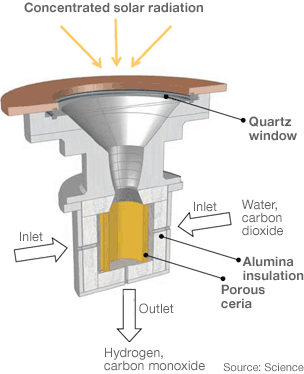Solar Funnels Convert Sunlight into Fuel
 An ongoing criticism of solar energy is that it only works during the day. This problem is being tackled in a plethora of different ways, from oversizing solar systems and connecting them to battery backups and thermal storage to creating syngas (synthetic gas) via algae. New research from CalTech and the Swiss Federal Institute of Technology are looking at a new way of producing hydrogen and syngasses in another way, by using solar funnels.
An ongoing criticism of solar energy is that it only works during the day. This problem is being tackled in a plethora of different ways, from oversizing solar systems and connecting them to battery backups and thermal storage to creating syngas (synthetic gas) via algae. New research from CalTech and the Swiss Federal Institute of Technology are looking at a new way of producing hydrogen and syngasses in another way, by using solar funnels.
CalTech Professor and researcher Sossina Haile and her colleagues published their research in the Dec. 24, 2010, edition of Science. The device that they developed is able to concentrate solar radiation and heat it up to 1,600 degrees Celsius. The resulting heat is used to split water or carbon dioxide into their constituent elements.
The device consists of a quartz lens that focusses the solar radiation on a reaction chamber. The reaction chamber is internally reflective, capturing most of the photons that enter the chamber and converting them to heat. The device heats up at a rate of 140 degrees Celsius a minute until it reaches about 1,250 degrees Celsius, and stabilizing at more than 1,400 degrees Celsius.
Through a two-step process, the device’s catalyst ceria (cerium dioxide) converts carbon dioxide or water into its constituent elements. “Ceria is a metal oxide, what that material will do when heated is it will release oxygen.…It happens at high temperatures, when we cool it back down it wants to absorb oxygen,” Haile said. The ceria replaces the oxygen by stripping it from the supplied material, carbon dioxide or water, thereby creating carbon monoxide—used for syngas, or hydrogen—which can be used directly. Either resulting fuel could be used to store the sun’s energy for use in power generation.
The funnels can be small, but they’re not nano-sized. “It’s like a sponge it’s porous and the gasses flow through it,” Haile said. But “it’s not nano because these temperatures are too high for nano-structures.”
At this point, the material isn’t efficient enough for commercial use. The prototype is inefficient, converting between 0.7 percent and 0.8 percent of the solar energy in the funnel into fuel. With advances that could change. “We calculated efficiency should be between 15 percent and 19 percent,” according to Haile. “We’re working with University of Minnesota on that. Right now it’s limited by the thermal design of the reactor. We need a better thermal design,” she said.
Image courtesy of Science



